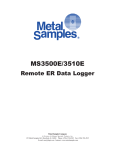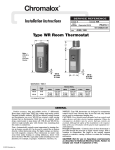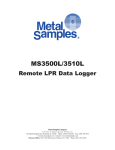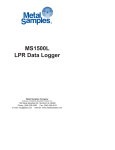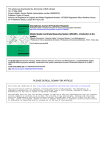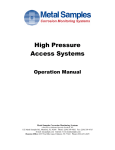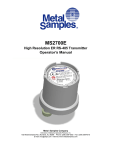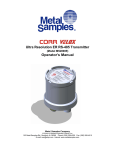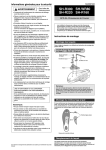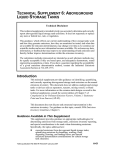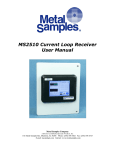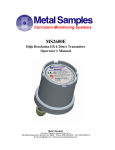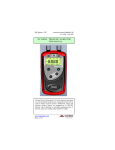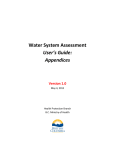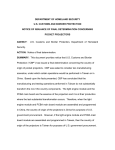Download MS1500E (v1) manual (revised 6-1
Transcript
MS1500E Data Logger (Version 1) Metal Samples Corrosion Monitoring Systems 152 Metal Samples Rd. Munford, AL 36268 Phone: (256) 358-4202 Fax: (256) 358-4515 E-mail: [email protected] Internet: www.metalsamples.com Houston Office: 6327 Teal Mist Lane, Fulshear TX 77441 Phone: (832) 451-6825 . Table of Contents I. Introduction ..................................................................... 1 A. General Description ..................................................... 1 B. Ports and battery replacement ...................................... 3 C. Specifications ............................................................... 5 II. Operation .......................................................................... 7 A. Select probe ID ............................................................. 9 B. Make measurement ..................................................... 12 C. Compute MIL/MPY .................................................... 14 D. Recall readings ............................................................ 15 E. Delete readings ............................................................ 15 F. Communications .......................................................... 16 G. Set time and date ......................................................... 26 H. Test mode ................................................................... 26 III. Theory of Operation ....................................................... 27 A. Measurement theory .................................................... 27 B. ER sensing elements ..................................................... 28 C. ER element performance .............................................. 31 D. ER probe body design ................................................. 35 1. Fixed length ER probe ............................................ 36 2. Retractable ER probe ............................................. 37 3. High pressure retrievable ER probe ......................... 38 IV. Testing the MS1500E with the ER Meter Prover ........ 39 V. Returning an Instrument for Repair .............................. 41 VI. Warranty ......................................................................... 43 . I. Introduction A. General Description The MS1500E is an intrinsically-safe, battery-powered, hand-held corrosion meter that enables you to directly take measurements from an electrical resistance probe, store the data, and upload directly to a computer. The unit features an easy-to-use Main Menu that will permit even an operator who is unfamiliar with the unit to take readings with ease. Corrosion rate measurements are made using the electrical resistance method. The electrical resistance method has a wide range of applications since it can be used in conductive or nonconductive environments including oil and gas. The unit measures the change in resistance of the probe element as metal loss occurs. The rate of change is directly proportional to the corrosion rate. After taking and storing a reading, the operator can display the metal loss in mils and the corrosion rate in mils per year (mpy). All measurements made with the unit are automatically time and date stamped with the MS1500E internal real time clock. If the MS1500E detects a probe with an internal leak or damaged element, a CHECK FAILED message occurs. The unit can take up to 3,100 readings and can be used with up to 150 probes. All stored readings are protected by a lithium back-up battery to prevent loss. Data may be selectively deleted from memory to accommodate additional information once the 3,100 reading capacity is reached. Alternatively, information may be downloaded to a PC as a comma delimited ASCII file for import into any of the standard data handling and analysis programs (e.g., EXCEL®, LOTUS 123®, Quattro Pro®). 1 The MS1500E may also be used as a data collection and transfer terminal for the MS3500E remote data logger. Accumulated data from several MS3500E field-based units may be locally downloaded to the MS1500E hand-held terminal, and then transferred to a PC for further analysis. The MS1500E offers seven operating modes: • Select Probe ID • Make Measurements • Compute • Recall • Delete Readings • Communicate • Set Time and Date All electrical resistance probe types can be used with this unit, including wire loop, tube loop, cylindrical element, surface strip, and flush mount probes. 2 B. Ports and Battery Replacement Use this cable to connect the MS1500E to a computer via serial port or USB port. COILED DATA CABLE MS1500 SERIAL PORT ADAPTER TO COMPUTER SERIAL PORT SERIAL TO USB ADAPTER (OPTIONAL) TO COMPUTER USB PORT 3 Use the port on top of the Top view of MS1500E MS1500E for connecting to a computer (with the cable provided) or to the MS3500E (with the Opti-link cable.) See Communications (p. 16) for more information. The battery compartment is accessed by removing the “slip-fit” cover on the rear of the instrument. Three 1.5VDC, AA size, dry cell batteries are placed in the spring loaded holders, following the plus/minus orientation indicated on the battery holder as illustrated below. FRONT BACK "SLIP-FIT" BATTERY COVER POWER SWITCH 3 X 'AA' ALKALINE BATTERIES (DURACEL MN1500 OR PC1500 REQUIRED FOR INTRINSIC SAFETY.) PROBE CONNECTOR 4 C. Specifications ER Probe Configurations Wire Loop Tube Loop Cylindrical Loop Flush Mount Surface Strip Battery: Three 1.5 Volt AA alkaline batteries Battery Life: 8 hours of continuous use Temperature Range: 32° to 120°F (0° to 49°C) Operational Humidity Range: 30% - 90% Storage Humidity Range: 5% - 95% Memory Protection: 10-year battery, back-up life Measurement/ Computations: Probe Life (0 - 100%) Metal Loss (Mils) Corrosion Rate (Mils/Year) Display: 4 lines x 20 characters LCD panel Maximum # of probe storage files: 150 Maximum # of stored readings: 3,100 5 Operating modes: Select probe ID (select/enter/delete probe ID) Make measurement Compute (metal loss and corrosion rate) Recall readings Delete readings Communicate (upload/download) Set time and date Communication port: RS-232 serial port Dimensions: 7.5" length x 4.0" width x 2.0" depth Weight: 1.5 lbs (5.2 lbs. with hardshell case) Intrinsic Safety: Class I, Division 1 Groups A, B, C, and D Temperature Code T3C Class I, Zone 0 Group IIC, T3C Conforms to ANSI/UL Std. 913 6 II. Operation Storage capacity The MS1500E allows you to measure metal loss and corrosion rate. Review this section which describes the functions that display on the Main Menu: The MS1500E allows a maximum of 3,100 readings with up to 150 probes. • Select probe ID • Make measurement • Compute MIL/MPY • Recall readings • Delete readings • Communications • Set time & date • Test mode To increase your free storage, which displays in the start-up screen, select from the Main Menu: • DELETE READINGS or • SELECT PROBE ID and then DELETE PROBE or ENTER NEW PROBE When you power up the MS1500E, the start-up screen confirms these checks: • the software version currently running • free storage available (see Storage capacity in margin) • system test pass The last display of the start-up screen looks like this: METAL SAMPLES MS1500E VX.X SYSTEM TEST : PASS 7 If you want to know how much storage is currently available, carefully watch the start-up screen which displays this information quickly before SYSTEM TEST PASS; then the Main Menu displays. Screen 1 of the Main Menu looks like this: SELECT PROBE ID MAKE MEASUREMENT COMPUTE MIL/MPY RECALL READINGS Screen 2 of the Main Menu looks like this: DELETE READINGS COMMUNICATIONS SET TIME & DATE TEST MODES To run a function, select it by using the up or down arrow and pressing ENTER. While in the Main Menu, pressing EXIT will return the selector icon to the first item of the Main Menu. 8 A. Select Probe ID The SELECT PROBE ID function allows you three options: Select a probe before you run a function In order for you to make measurements, compute mil/mpy or recall or delete readings, you must select a probe that is currently in memory. The MS1500E provides you with a list of probes in memory; use the arrow key to select one and press enter. Now you’re ready to run any other function. • select a probe already in memory for which you wish to run any other feature of the MS1500E (Make Measure ment, Compute mil/mpy, Recall Readings, or Delete Readings); • enter into memory the identifi cation of a new probe • delete from memory the identification of a probe To run any of these three options, choose SELECT PROBE ID from the Main Menu. SELECT PROBE ID MAKE MEASUREMENT COMPUTE MIL/MPY RECALL READINGS The next screen allows you to choose the functions to ENTER or DELETE a probe ID or to select a probe ID from those already in memory for which you wish to make measurements. 9 To assist you with selecting a probe ID, the screen displays a list of all probe IDs currently in memory. Entering information To enter a number, type it using the keypad numbers. Select from the list of probes in memory the probe for which you wish to run a function (Make Measurement, Compute mil/mpy, Recall Readings, Delete Readings). If you make an error, press the down arrow this allows you to type the number again. Pressing the up arrow retains the ID number you typed in. Entering probe type The MS1500E has a list of probe types in memory. Select one by pressing the arrow keys. (See Appendix B for a list of probe types supported by the MS1500E.) ENTER NEW PROBE DELETE PROBE 1234 WIRE 40 4567 FLUSH 20 1. Press the arrow key to select a probe ID. 2. Press ENTER. To enter the ID of a new probe, select ENTER NEW PROBE; the next screen allows you to enter the ID number and the type. 1. Enter the probe ID - use the number keys (press the DOWN arrow if you make an error). 2. Press the UP arrow when you’ve entered the correct ID number. 3. Enter probe TYPE (see margin). 4. Press ENTER. 10 PROBE ID: 5385 PROBE TYPE: WIRE 40 USE ARROW KEYS Deleting probes It’s necessary to delete a probe when you replace one. Note that when you delete a probe, you also delete all the readings for that probe. You might want to transfer the readings to a computer before deleting them by using the COMMUNICATIONS option in the Main Menu. (See Communications, p. 16.) It is occasionally necessary to remove the ID of a probe from memory, for example: • when the memory bank is full • when a probe is no longer used To delete the ID of a probe in memory, select DELETE PROBE. DELETE PROBE PROBE ID: UP ARROW WHEN DONE 1. Enter the probe ID - use the number keys (press the DOWN arrow if you make an error). 2. Press the UP arrow when you’ve entered the correct ID number. The instrument will confirm your choice of probe ID before deleting it from memory. 11 B. Make Measurement To take measurements from probes in memory, select MAKE MEASUREMENT from the Main Menu: Select a probe before you run the function In order for you to run MAKE MEASUREMENT, you must have already selected a probe from memory. See Select Probe ID from the Main Menu (see page 9). SELECT PROBE ID MAKE MEASUREMENT COMPUTE MIL/MPY RECALL READINGS The next screen displays the Probe ID that you selected earlier from the Main Menu item SELECT PROBE ID. Set time and date To ensure readings you make are accurate, be sure the time and date settings in the MS1500E are correct (see page 26). PROBE ID: 1234 PRESS ENTER TO START When you press ENTER, the MS1500E checks the probe for correct operation. The next screen then displays the results of that check as PASSED or FAILED. 12 If the probe failed the test, this screen displays: PROBE ID: 1234 PROBE CHECK FAILED PRESS EXIT Check failed = bad probe When a probe fails this test and the screen displays CHECK FAILED, it means the probe may have either a damaged element or an internal leak. Press EXIT to return to the Main Menu. If the probe passed, this screen displays: Replace a probe that results in a CHECK FAILED. PROBE ID: 1234 PROBE CHECK PASSED PRESS ENTER TO READ Press ENTER to view the reading: PROBE ID: 1234 READING: 124 PRESS ENTER TO SAVE Press ENTER to save the reading in memory. Saved readings also include the date. Press EXIT to return to the Main Menu. 13 C. Compute MIL/MPY Select a probe before you run a function In order for you to run COMPUTE MIL/MPY, RECALL READINGS or DELETE READINGS, you must have already selected a probe from memory. Select COMPUTE MIL/MPY to review data from the last reading on a probe. The MS1500E calculates these data from a comparison between the last reading and the first reading on the probe: 20/01/98 TO 20/02/98 MET LOSS: 0.05 MIL COR RATE: 0.59 MPY PRESS EXIT See Select Probe ID from the Main Menu (see page 9). Press EXIT to return to the Main Menu. 14 D. Recall Readings Select RECALL READINGS to look at data from different dates. Use the arrow keys to choose the reading number. Or press ENTER to type in the number on the keypad. READING #: 2 DATE: 20/02/98 READING: 124 DOWN/UP/EXIT/ENTER Press EXIT to return to the Main Menu. E. Delete Readings Select DELETE READINGS to erase a reading from memory. Periodically delete readings to create more free storage area in memory. DELETE READINGS #1 20/01/98 125 #2 20/02/98 125 ENTER TO DELETE Press EXIT to return to the Main Menu. 15 F. Communications The MS1500E Data Logger has the ability to store readings as they are taken. These readings can later be transferred to your PC via serial port or USB port. To transfer data to a PC it is necessary to install the Corrosion Data Management Software. Installing the Software To run the Corrosion Data Management Software, you need a PC that meets the following requirements: • • • • • • • • Pentium® class processor Windows® 95 or higher operating system 16 MB of RAM 10 MB of available hard-disk space VGA monitor with 800 600 or greater resolution Mouse or pointing device recommended Available 9-pin serial port or USB port CD-ROM drive for software installation To install the Corrosion Data Management Software: 1. Insert the setup disk provided in your accessory kit. 2. You will be prompted to close any open programs. After you have done so, click OK to continue. 16 3. Click the install button to begin installation. Note, it is recommended that you install the software in the default directory. 4. After clicking the install button, the software will be installed on your PC. 5. When the software installation is complete you should remove the setup disk, then reboot your computer. 17 Instrument Download Center The Instrument Download Center is a simple tool for retrieving data from Metal Samples ER and LPR data logger instruments. To download data from an instrument: • • • • • • • • Connect the instrument to an available PC serial port or USB port (see page 3.) Turn the MS1500E on. Run the Corrosion Data Management Software Open the Instrument Download Center Select the serial port and instrument Click the Download button (ensure that Part Status toggles to “On”). From the main menu of the instrument, go to the Select Probe I.D. menu and select the probe data you wish to download. From the main menu of the instrument, go to the Communications menu and select Computer Upload. Data will begin to transfer from the instrument to the PC, and will appear in the data window of the Instrument Download Center as shown above. If the data appears garbled, the wrong instrument type has been selected. Select another instrument type and try again. If data does not appear in the data window at all, verify that: 18 • • • • • The instrument is connected to a valid serial or USB port All cables are securely connected The message “Port Status: On” appears in the status bar There are no errors on the instrument If using a USB adapter, ensure that the device drivers have been installed. Selecting a Serial Port Use the Serial Port selection box to select the port to which the instrument is connected. If the COM port number is unknown, it can be found in Windows Device Manager under “Ports (COM & LPT)”. Selecting an Instrument Use the Instrument option box to select the model of Metal Samples instrument being downloaded. This sets the appropriate communication parameters, which will be displayed in the status bar at the bottom of the window (“9600,N,8,1” for an MS1500, “2400,N,8,1” for an MS3500). Downloading Data To toggle the selected port on and off, click the Download button. Toggling the port on and off will also clear the data window. Once a valid serial port and instrument have been selected, click the Download button to turn the port on and enable the computer to receive data. If a valid serial port has been selected, the status bar at the bottom of the window will display the message “Port Status: On”. If an invalid serial port has been selected, an error message will appear, and the status bar will display the message “Port Status: Off”. If this happens, another serial port should be selected. 19 Saving Data To save the data in the data window, click the Save button. The data is comma-delimited ASCII text. It can be saved to a standard text (.txt) file, or it can be saved to a comma-separated values (.csv) file, which greatly simplifies the process of importing the data into some spreadsheet programs such as Excel® or Quattro Pro®. Printing Data To print the contents of the data window, click the Print button. A print dialog box will be displayed to allow printer selection and setup. Charting Data To chart the contents of the data window, click the Chart Data button. If the data has not yet been saved, the user will be prompted to do so before the charting process begins. For more information on charting data, see the Data Analysis section. Data Analysis The Data Analysis utility is a convenient tool for charting data from Metal Samples ER and LPR data logger instruments. The Data Analysis utility can be opened from the Main Menu, or it can be opened directly from the Instrument Download Center. If the Data Analysis utility is opened from the Instrument Download Center, the contents of the data window will be loaded into the chart. However, if the Data Analysis utility is opened directly from the Main Menu, a valid data file must be loaded. The Select File box will open to allow selection of a data file. 20 Loading a Data File After selecting a data file (or clicking the Chart Data button from the Instrument Download Center) a status window will display the progress of the file being opened, along with the Instrument Type, Probe Type, and Probe ID for the data file. Data Table After a file has been successfully loaded, the data will be displayed in the Data Table for review. By default, all data points will be included in the chart. However, data points can be turned off, or excluded, from the chart. If the “Excluded” flag appears in the status column for a data point, that data point will not appear in the chart. To toggle the exclude/ include status of a data point, double-click the data point, or select the data point and click Exclude/Include in the Options menu. Printing Data The data table can be printed by clicking Print in the Options menu. A print dialog box will be displayed to allow printer selection and setup. 21 Creating A Chart To chart the selected data, click the Chart Data button, or select Chart Data from the Options menu. The chart will be displayed in a new window. Printing a Chart A chart can be printed using the Print Chart option in the File menu. A print dialog box will be displayed to allow printer selection and setup. Exporting a Chart A chart can be exported to other applications using the Copy Chart option in the File menu. This will copy both the chart and the raw data to the Windows® Clipboard. The chart can then be inserted into other applications using the Paste function. Note: In some applications, using the Paste function will insert the raw data instead of the chart. In this case, use the Paste Special function, then select Picture to insert the chart. Chart Tools • Statistical Data The Statistical Data tab at the bottom of the Data Chart window will display a page with statistical information about the chart data. If the Statistical Data page is visible, this information can be printed by clicking Print Statistical Data in the File menu. 22 • Finding A Data Points Value While viewing the chart, the value of any data point can be determined by simply clicking it. The value will be displayed in the charts tool-tip box (a small text box that is displayed near the mouse pointer). If the tool-tip box does not appear immediately after clicking the data point, hold the mouse pointer stationary over the chart background for a moment. • The Tools Menu The Tools menu contains a collection of utilities for viewing and manipulating the chart. The Tools menu can be accessed by clicking Tools on the menu bar, or by right-clicking anywhere on the chart. o Data Markers Show Data Markers toggles the data markers on and off. o Mean Value Show Mean Value toggles the mean value line on and off. o Trend Line Show Trend Line toggles the trend line on and off. 23 o Title/Footnote Setup Title/Footnote Setup displays a window that allows the chart title and footnotes to be toggled on and off, and to be modified. o Plot Setup Plot Setup displays a window that allows configuration of Y-axis scaling, and of the chart type. The Y-axis can be scaled to default values by checking the Auto Scaling option box. The Y-axis can be scaled to manual values by un-checking the Auto Scaling box, then entering the desired values in the Minimum and Maximum fields. The chart type can be set to Line Chart, Bar Chart, or Area Chart by selecting the appropriate button in the Chart Type box. The default chart type is Line Chart. o Data Series Color Data Series Color displays a color selection box, which allows the user to select the brush color for the plot line. The default color for the plot line is Blue. o Zoom In Zoom In allows a region of the chart to be enlarged so that it may be viewed in greater detail. To enlarge a region of the chart, click on the two data points that define the left and right boundaries of the region. In zoom mode, the mouse pointer will change to a crosshair. When zoom mode ends, the mouse pointer will return to its normal state. To cancel zoom mode, click Cancel Zoom In from the Tools menu, or simply press the Esc key. 24 o Zoom Out Zoom Out restores the initial view of the chart, which displays the full data set. o Calculate Corrosion Rate If the chart contains ER data, the Calculate Corrosion Rate option will become available under the Tools menu. This option allows the corrosion rate to be calculated between any two data points on the chart. To calculate the corrosion rate click Calculate Corrosion Rate, then click two data points. The corrosion rate between those two data points will be displayed. In calculate mode, the mouse pointer will change to an arrow/question mark. When calculate mode ends, the mouse pointer will return to its normal state. To cancel a calculation, click Cancel Calculate from the Tools menu, or simply press the Esc key. 25 G. Set Time and Date Caution The time and date are set at the factory, but may need to be adjusted to your time zone. Also, if you try to change the date or time and it conflicts with stored information, the MS1500E will display N/A. When you need to set the internal clock, select SET TIME & DATE. In order for information in memory to be useful and accurate, be sure the time and date are accurate. SET TIME & DATE 11:46 AM 20/02/98 ENTER TO ACCEPT Use the numbers on the keypad and the arrow keys to make changes to the time and date. Note: The MS1500E uses the international date format (DD/MM/YY). Be Sure to enter the date in this format to prevent errors in data handling and calculations. Press ENTER to confirm your changes and to return to the Main Menu, or press EXIT to discard your changes. H. Test Mode This function of the instrument is used by authorized factory personnel for servicing or upgrading the MS1500E. E 2939 O153R1364 O151 G57 RATIO 0.4641 READING: 122 #105 PROBE: 1234-WIRE 40 26 III. Theory of Operation A. Measurement Theory The reduction in cross-sectional area of an element of metal or alloy as it corrodes is accompanied by a corresponding increase in the electrical resistance of the element. The relationship is given by R= x L/A .............................(1) R = element resistance = specific resistivity of the element alloy A = element cross-sectional area L = element length Consequently, periodic resistance measurements of a metal/alloy element that is continuously exposed to a corrosive environment, will provide data on the rate and extent of corrosion for that alloy/ environment combination. In practice, resistance is also a function of temperature. Therefore, electrical resistance corrosion sensors need some means to compensate for the effects of temperature change. This is achieved by constructing the sensors such that the sensing element has an exposed portion that freely corrodes and a protected portion that is within the body of the sensor and not subject to corrosion. Such a construction is illustrated in Figure 1. Figure 1: Temperature compensated element 27 The resistance of both the exposed (RE) and protected (RT) portions of the sensors are equally influenced by temperature. Consequently, the resistance ratio of the exposed to protected elements is a function only of the loss in metal thickness on the exposed element, and therefore of corrosion. This resistance ratio (RE/RT) is measured either periodically with a portable instrument, or continuously with a variety of continuous, automatic recording/data logging instruments and read as percentage thickness loss. Thus, total metal loss versus time is directly available, and corrosion rate is indirectly available as the slope of the line for metal loss versus time. Figure 2: Typical data 28 B. ER Sensing Elements Electrical resistance probe elements are offered in a variety of thicknesses and geometries. The most common are illustrated below: Wire Loop Cylindrical Tube Loop Flush Figure 3: Element styles Tubular loop elements are constructed from thin-walled tubing. Their small cross-section allows fast response at low corrosion rates. Wire loop elements, constructed of solid wire, provide a good compromise between sensitivity and long life. They are typically used for systems exhibiting moderate corrosion rates (5-20 mpy). Cylindrical elements are made from hollow cylinders and are extremely robust. They are widely used in high temperatures and high flow rate conditions. They tend to be sensitive to noise and somewhat sluggish in response. Consequently, they are only recommended for moderate to high corrosion rates (20-50 mpy). Flush elements are designed to be located flush with the corroding surface of the vessel/pipe, consequently, most closely simulating true corrosion rates. The flush element is useful in high flow regimens and operating conditions where internal obstructions are not permissible, e.g. pigged pipelines. The mechanism for sealing elements into probe bodies varies. For example, the cylindrical type elements are sealed with an all metal weld, whereas flush elements are sealed with an epoxy seal. 29 The sealing mechanism of the element is a primary factor in determining the temperature and pressure rating of an ER probe. Table 1 provides a guide to temperature and pressure limitations for various element designs. Ele me nt Form Pre s s ure Rating PSI Te mpe rature Rating °F / °C TU04 TU08 1500 500 / 260 40 mil 80 mil WR40 WR80 1500 500 / 260 cylindrical element all metal 10 mil 20 mil CT10 CT20 1500 500 / 260 flush element epoxy seal 5 mil 10 mil FM5 FM10 1500 400 / 204 Thickne s s Ele me nt ID tubular loop glass sealed 4 mil 8 mil wire loop glass sealed Table 1: Element temperature and pressure ratings The temperature and pressure limitations given above may be subject to modification according to the probe body design. This is discussed later in this manual. A final issue with respect to sensing elements is material of construction. Generally, this should be selected to most nearly match that of the plant or equipment under consideration. Almost any geometric configuration and thickness of element can be made in any commercially available alloy. However, some alloys, particularly in the glass sealed loop version, may be costly and have a considerable delivery time. 30 C. ER Element Performance The basic ER measurement gives percentage of metal thickness loss and is a function of the original element thickness. Essentially, total metal loss and corrosion rate are given by the following functions: ML X X2 X1 t CR K = = = = = = = ML = X x K 1000 CR = (X2 - X1) x K x 365 ................... (3) 1000 t ........................................ (2) METAL LOSS IN MILS INSTRUMENT READING AT ANY GIVEN TIME INSTRUMENT READING AT TIME t2 INSTRUMENT READING AT TIME t1 TIME LAPSE (DAYS) BETWEEN READINGS X1 AND X2 CORROSION RATE IN MILS PER YEAR PROBE CONSTANT 31 The probe constant K is a function of the element thickness and geometry. Table 2 lists the K factors for various common elements. ELEMENT GEOMETRY K FACTOR TU04 TU08 WR40 WR80 CT10 CT20 FM5 FM10 FM20 FM40 2 4 10 20 5 10 2.5 5 10 20 Table 2: K factors Some of the newer instruments, the MS1500E in particular, perform metal loss and corrosion rate calculations automatically and display these as a direct reading. Two key performance characteristics for a particular element style are element life and response time. The element life is directly proportional to its thickness, whereas response time, which is the time required to obtain a significant reading change at a given corrosion rate, is inversely proportional to element thickness. Thus, the user must make some compromise between life and response time when selecting a sensing element. Figures 4 and 5 provide a general guide for selecting optimum life and response time combinations. 32 Figure 4: Element selection guide (element life) 33 Figure 5: Element selection guide (response time) 34 The other major performance characteristic related to element geometry is measurement reproducibility. Under ideal circumstances the measurement reproducibility will match the instrument resolution, which is ±0.1% for most commercially available units. However, low resistance elements (i.e., CT20, WR80) in systems exhibiting frequent (30-60 minute cycle), and comparatively large (±10-15°F), temperature fluctuation may only achieve a reproducibility of ±0.5%. Such low resistance elements should be avoided when temperature instability is anticipated, unless high corrosion rates are expected (20+ mpy). D. ER Probe Body Design ER probe bodies may be made in almost any design and material. Metal Samples Corrosion Monitoring Systems frequently supplies custom probe designs for atypical applications. However, a standard range of designs are available that will cover the majority of uses. These standard designs are discussed in the following paragraphs. 35 1. Fixed Length ER Probe The fixed length probe, which has a body constructed in 316L stainless steel, is a general purpose probe construction. The probe is comprised of a NPT pipe plug entry or welded flange on a cylindrical shaft. The probe is available in a variety of insertion lengths, although no length adjustment is available; hence the name “fixed-length” probe. This probe is available in all element styles. The wire loop and cylindrical elements can use threaded ports as small as 3/4" NPT. The flush mount elements require at least a 1½” NPT opening. Pressure and temperature ratings are 3000PSI and 500°F for pipe plug entries, whereas flanged entries are controlled by the flange rating. The major limitation of this design is that the system needs depressurization prior to insertion or removal of the probe. Wire, Tube or Strip Loop Element Figure 6: Fixed Length ER Probe 36 2. Retractable ER Probes Retractable probes are the industry standard in refinery and petrochemical plants. The probe body is constructed in 316L stainless steel and compromises a one inch FNPT packing gland with a cylindrical probe shaft. Four basic probe lengths are available: 18", 24", 30", and 36". However, the insertion is adjustable through the packing gland to provide any desired insertion. The retractable probe is inserted into the system through a customer supplied ball valve and can be inserted or removed from pressurized systems without shutdown. Retractable probes can be operated at pressures to 1500 psi and 500°F. Metal Samples Corrosion Monitoring Systems’ Easy Tool is recommended for probe insertion or retraction in systems with pressure over 150 pounds. All element configurations are available for retractable probes and most can be accommodated through a 1" full-port valve. Flush element probes, however, require a 1½” full-port valve. Safety Chain Packing Gland Assembly Nipple Retractable ER Probe Bleed Valve 1” Full Port Valve Velocity Shield (Optional) Safety Nut Figure 7: Retractable ER Probe 37 3. High Pressure Retrievable ER Probe The high pressure retrievable probe is widely used in the oil and gas production and transmission industry and is part of a specially designed insertion/retraction system. The probe is mounted on a specially designed plug and inserted through a welded or flanged access fitting as shown in Figure 8. The retrievable probe, which is normally constructed in AISI316L stainless steel, can be inserted and removed from systems operating up to 3600 psi without system shutdown. This is achieved by using a portable valve and retrieval tool that can be moved from probe location to probe location as insertion or removal is required. Probe Adapter Cover HP Hollow Plug Assembly HP Access Fitting Retrievable ER Probe (Shown with Velocity Shield) Figure 8:Retrievable ER Probe 38 IV. Testing the MS1500E with the ER Meter Prover An ER Meter Prover is provided to allow routine checks of the MS1500E instrument. The ER Meter Prover simulates a Wire Loop type ER probe at a fixed value which is printed on the Meter Prover label (as shown below.) To test the MS1500E with the Meter Prover: 1) Enter a new Probe ID in the MS1500E menu with the probe type Wire 40 (see “ENTER NEW PROBE” on page 10.) This Probe ID can be used for future checks with the Meter Prover. 2) Connect the ER Meter Prover to the MS1500E probe connector as shown to the right. 3) Perform a measurement by selecting “MAKE MEASUREMENT” from the main menu (see page 12.) 4) Allow the measurement to finish. The measured value should be close the value printed on the ER Meter Prover label (+/- 10 probe units is typical, but may vary more depending on ambient conditions at the time.) If the reading shows a significant difference compared to the Meter Prover value, further troubleshooting may be required. 39 It is important to note that the ER Meter Prover is only a check probe used to verify general instrument operation. It is not a calibration standard. The measured value may differ from the listed value as explained in step 3 above. It is also important to note that each ER Meter Prover is serialized to match the instrument it is shipped with, and its measured value may differ if it is used with another meter. If it is necessary to use an ER Meter Prover with another meter, it is recommended that you establish a baseline value for the ER Meter Prover with the other meter. 40 V. Returning an Instrument for Repair If it is necessary to return any Metal Samples Corrosion Monitoring Systems (MSCMS) instrument for repair, the following procedure is recommended to ensure the fastest possible repair and return cycle. You may contact MSCMS to verify that returning the instrument is necessary. 1. If possible, pack the instrument in the original shipping carton. If the original carton is not available, pack the instrument in a rigid cardboard or wood carton. Surround the instrument with a minimum of three inches of resilient packing material such as foam rubber or shredded newspaper. 2. Ship the instrument prepaid via air freight or air express to: Metal Samples Corrosion Monitoring Systems 152 Metal Samples Rd Munford, AL 36268 3. Contact MSCMS by telephone (256) 358-4202, fax (256) 358-4515, or e-mail [email protected] and tell them: a. the name of the airline carrying the instrument b. the flight number c. the estimated time of arrival d. the waybill number and delivery instructions 4. When the instrument is packed, include a copy of the form on the next page, filled in as required to expedite the repairs. 41 Copy this form when you need to return an instrument. Send a copy of this form filled in as completely as possible. 1. Check one: Repair this instrument under warranty. Repair this instrument regardless of problem or cost of repair. Inspect this instrument and advise customer of approximate cost of repairs if instrument is not covered under warranty (Note: This may delay return of instrument to customer.) 2. Instrument Model # Serial # Date of purchase Customer’s original purchase order # 3. Return this instrument to: Company City/State/Zip Telephone Fax 4. Describe problem fully - this may shorten repair time. 5. Urgency of repairs 42 VI. Warranty Metal Samples Corrosion Monitoring Systems (MSCMS) warrants that any part of MSCMS corrosion rate instruments and accessories which proves to be defective in material or workmanship within one year of the date of original shipment to Purchaser will be repaired or replaced, at the option of MSCMS, free of charge. This warranty does not cover (1) probe assemblies, (2) items expendable in nature, or (3) items subject to damage from normal wear, misuse or abuse, or failure to follow use and care instructions. All damaged items are to be shipped at Purchaser’s expense to and from MSCMS. MSCMS shall have the right to final determination as to the existence and cause of the defect. The foregoing shall constitute the sole and exclusive remedy of any purchaser of MSCMS products for breach of warranty and is exclusive and in lieu of all other warranties, expressed, implied or statutory, including the implied warranties or merchantability and fitness. In no event shall MSCMS be liable for special or consequential damages or for any delay in the performance of this warranty due to causes beyond its control. Orders or requests for additional information should be addressed to: Metal Samples Corrosion Monitoring Systems 152 Metal Samples Rd Munford, AL 36268 Phone: (256) 358-4202 Fax: (256) 358-4515 E-mail: [email protected] The technical information and suggestions contained herein are believed to be reliable, but they are not to be construed as warranties since conditions of use are beyond our control. 43















































